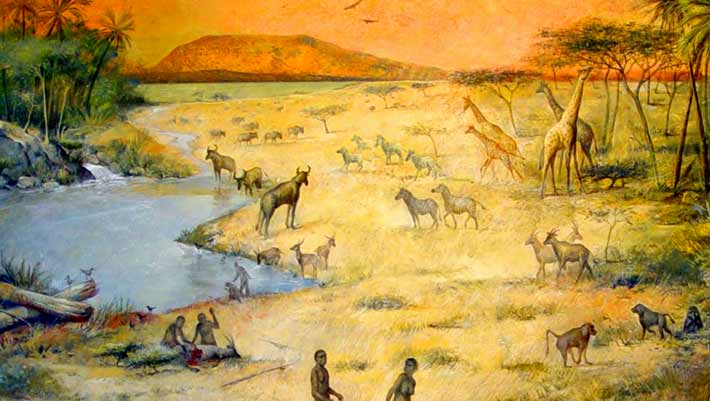Eastern Africa preserves the most complete record of human evolution anywhere in the world but scientists have little knowledge of how long-term biogeographic dynamics in this region influenced diversity and distribution of hominins.
An artist’s rendition of an early human habitat in Tanzania 1.8 million years ago. Image credit: M. Lopez-Herrera / Enrique Baquedano / Olduvai Paleoanthropology and Paleoecology Project.
In the new research, Dr. Ignacio Lazagabaster of the National Research Center on Human Evolution (CENIEH) and his colleagues focused on the fossil record of mammals from the East African Rift System.
“Late Cenozoic fossil sequences in the East African Rift System provide the richest, longest and most continuous records of human evolution and its environmental context anywhere in the world,” the authors explained.
“As such, the hominin and faunal records of eastern Africa have occupied a central role in understanding the factors that shaped human evolutionary history.”
“Our study offers new perspectives on how climatic and environmental changes influenced the evolution of mammals and hominins over the last 6 million years,” Dr. Lazagabaster said.
“It highlights in particular how biotic homogenization, which is the process by which the faunas of different regions become more similar in composition, has been a crucial factor in the evolution of the ecosystems and the species inhabiting them.”
“By means of beta diversity analysis, which is the relationship between local and regional biodiversity, we are able to track how the changes in vegetation and climate have driven dispersion and extinction patterns over time.”
They found that the faunas of the Late Miocene and Pliocene (between around 3 and 6 million years ago) were mainly comprised of endemic species.
A change toward biotic homogenization, or faunal uniformity, started about 3 million years ago, driven by the loss of endemic species in functional groups and a rise in the number of grazing species shared between regions.
This important biogeographic transition matches closely the regional expansion of ecosystems dominated by graminoids and pastures of type C4, which grow better in warm and dry climates.
These environmental changes directly impacted the feeding and mobility patterns of the hominins and faunas that shared their habitat.
“Given that the hominins were certainly influenced by many of the same factors as other mammals in eastern Africa, this work offers a new perspective on the links between environmental and human evolutionary changes, with an integrative approach that furnishes us with a framework for future research and for testing hypotheses about the adaptation of hominins to their surroundings,” Dr. Lazagabaster said.
The study was published July 15, 2024 in the journal Nature Ecology & Evolution.
_____
J. Rowan et al. Long-term biotic homogenization in the East African Rift System over the last 6 million years of hominin evolution. Nat Ecol Evol, published online July 15, 2024; doi: 10.1038/s41559-024-02462-0
Source link : https://www.sci.news/othersciences/anthropology/hominin-evolution-eastern-africa-13124.html
Author :
Publish date : 2024-07-23 22:02:12
Copyright for syndicated content belongs to the linked Source.
